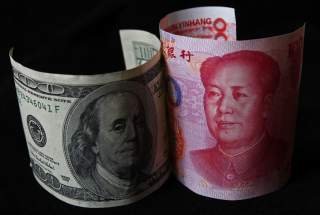Why China Is Not Backing Down in the Trade War
And what it means for Washington.
The past couple of weeks have seen a dramatic downturn in the U.S.-China trade negotiations wiping out over $1 trillion of the global stock markets. It’s tempting to think the economic ramifications will motivate negotiators on both sides to quickly come back to a deal. But the latest developments suggest that we should instead expect a lot more turbulence ahead.
Those looking to understand the ongoing trade conflict would be wise to recognize that it’s no longer just a matter of trade policy. More importantly, it’s a battle against an economic development model directed by an authoritarian government—and both sides appear ever more belligerent in the fight.
To begin with, China has been increasingly committed to its brand of state capitalism since President Donald Trump started to challenge it, and you can tell by reading the tea leaves in the Chinese government’s pronouncements.
Last year, we developed a machine learning program, the Policy Change Index (PCI) for China, to do just that. The program “reads” the People’s Daily—the Communist Party of China’s official newspaper—and, from there, predicts whether the Chinese government will change its policies. Beijing’s rigid propaganda apparatus is predictive because of the Soviet model of governance China has been subscribed to since 1949. As Lenin proclaimed in 1920, “the whole task of the Communists is to be able to convince the backward elements [in society]” of their (future) policy agenda. And state-run media like the People’s Daily are where the convincing takes place most prominently—before the fact.
The PCI project has direct implications on the U.S.-China trade fight, which centers around a set of thorny structural issues in the Chinese economy. Using the predictive algorithm, we have been saying for months that China has not yet shown any signs of backing down on the U.S. demands. In fact, since before the trade conflict started over a year ago, the Chinese government has been increasingly propagandizing patriotism, the importance of gaining global leadership, and the necessity of using state directives to achieve that goal—in short, exactly what the United States is trying to counter. The latest breakdown in talks should be no surprise to anyone who understands the Chinese side of the bargain.
However, we did learn something new in the most recent episode, and it’s how resolute the American side is in the current standoff. It’s widely reported—and hardly refuted—that the talks broke down because China reneged on previous promises related to enforcement mechanisms (such as changing its own laws), which prompted President Trump, advised by his negotiators, to up the tariffs. Many often argue that stock market considerations would drive President Trump toward a deal. But that wasn’t true in late 2018, and it doesn’t seem to be the case now. From the 2017 National Security Strategy to Vice President Pence’s 2018 Hudson Institute speech, to the ongoing trade impasse, the Trump administration’s China policy has been, perhaps surprisingly, coherent.
What does all this mean for the long run?
There’s no question that tariffs are never a good economic policy. But one cannot overemphasize the fact that the U.S.-China trade war has gone beyond an economic policy issue. It represents a rare American challenge to China’s authoritarian economic model that used to work wonders but has been in limbo for years.
Moreover, as we have shown using the PCI project, the Chinese economy has been in a state of policy confusion since Former President Hu Jintao launched his “harmonious society” initiative in 2005. The cause of the confusion is an attempt to maintain pro-market economic reforms while using government directives to tackle social problems. While the contradiction is getting worse under President Xi, it’s a wide-open question whether any force, internal or external, can change that anytime soon.
The Trump administration is running an undoubtedly risky gambit with the trade war—partly at the expense of the Americans—trying to change Chinese behavior. While it hasn’t worked yet, Chinese behavior does change, at times, due to external pressures. The last time China was in a state of policy confusion, for example, was from the late 1980s to the early 1990s. The external pressures in the aftermath of the Tiananmen Square protests exacerbated China’s economic downturn, eventually leading to another wave of drastic reforms and opening.
It would be a mistake to think that President Trump’s China policy is doomed to fail. It’s also far from clear if his strategy will see China return to the pro-market path. For this reason, it would be wise to brace for more uncertainties in the coming months, if not years, while Trump’s gambit is in the works.
Weifeng Zhong is a senior research fellow with the Mercatus Center at George Mason University. Julian TszKin Chan is a senior economist at Bates White Economic Consulting. The views expressed here are solely those of the authors.
Image: Reuters

